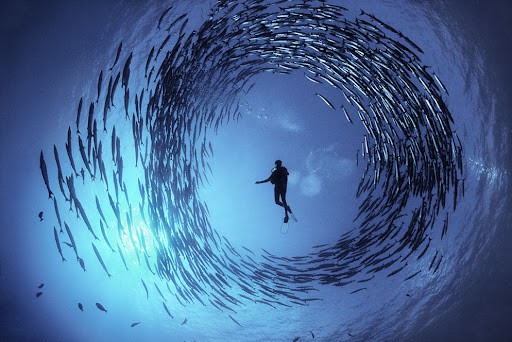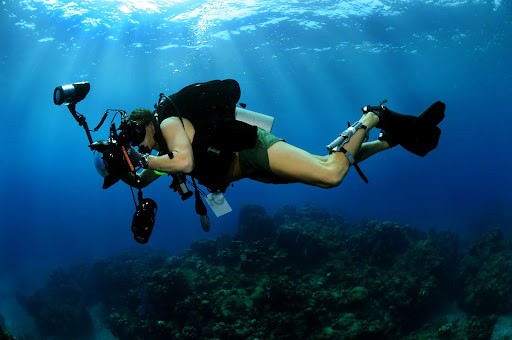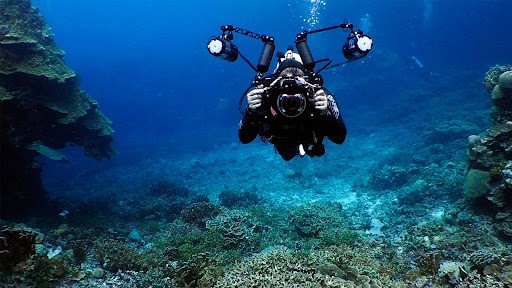A Quick Guide to Underwater Photography 2022

Our world is full of scenes and moments that are worth capturing. Photography brought us a unique opportunity not only to perpetuate the beauty of the moment but also to create memories that won’t fade away. We shoot scenes of daily life to show that everything we consider mundane is actually an art in its own right, something we forget too often and need to be constantly reminded of. We use cameras to capture those valuable moments that only happen once not to let the toll of time make them bleak in our memory. Wherever we go, whatever we do, there is beauty to be found. And there is no better way to share it with other people than to take a picture.
One day, one clueless creature decided to see what the overwater world had to offer. And here we are, terrestrial beings that can only make brief visits to the aquatic kingdom. The transience of those trips intensifies our perception and makes everything look even more mesmerizing, even though underwater scenery needs no assistance to bewitch a viewer. The scenes of the submarine realm undoubtedly deserve to be commemorated in photos, and our outdoor sports store helps people do so. Usually, we only provide people with equipment, but today’s the day for some theory. Here’s a brief underwater photography guide.
Things to Own
Every trip, big or small, calls for some preparation. That is, if it’s the best experience you’re after. There are two equally important components that one needs to take care of. There is no hierarchy to them since one is useless without the other, but we shall begin with equipment. The least you need for surface photography is a device capable of taking pictures. Things aren’t that simple for underwater photography, though. The marine world lives by different rules, rules you need to comply with if you want your photo shoot to be productive.
Diving Equipment
First and foremost, you need something that will allow you to stay underwater for more than a minute. That’s where the diving equipment comes in. Even though a photo taken on a knee depth still counts as underwater, those are not the scenes you buy underwater cameras for. To withstand the hostile impact of water and pressure, donning diving equipment is a must. If you are just passionate about taking some photos from your vacation and have no plans of turning underwater photography into a profession, renting might be the thing to do. However, if you are determined to do it regularly, getting your own set will save you money in the long run. You won’t pull this trick on compressed air tanks (since they need to be refilled somewhere), but things like dive suits, fins, masks, and accessories are a reasonable purchase.
Camera
Once you find yourself immersed and safe, it’s time to put your camera to use. There are two roads you can take when deciding on which camera to buy. The first road leads to a group of dedicated cameras that were designed specifically for use in underwater environments. They feature a sealed construction that won’t allow water to mess with their innards and are configured for low-light picture-taking. Another option is using regular cameras (like DSLRs or mirrorless ones). This approach might be preferable for full-time photographers who’ve already invested a small fortune into their equipment and know it like the back of their hands. However, taking it underwater in its original configuration would mean killing it with your own hands. You need another piece of equipment to make this work.
Underwater Housing
Underwater housing is the one and only line of defense that can protect cameras from the impact of water and increased pressure. If you’ve already spent a decent sum on a camera, there is little sense to skimp on underwater housing. You want your investment protected, and that’s what housings are for. Though prioritizing protective qualities is a no-brainer, don’t forget that you need convenient access to your camera’s controls. Buttons and dials that can ensure that interaction are a must.
Lenses
There are no lenses, designed specifically for underwater shooting, but the choice of lenses is already plentiful. Professional photographers know better than anyone which lenses they need. Amateur photographers won’t probably see much difference and are better off with ready underwater cameras. Just be aware that you can change lenses on both types of cameras.
Lighting
Lighting is one of the issues that accompany every underwater photoshoot. Even on the sunniest days, the visibility in underwater environments leaves much to be desired. The deeper you go, the darker it gets, but don’t let the environment dictate its terms. Even though natural lighting is the photographer’s best helper, it won’t be sufficient in greater depths. That’s why you need your own set of lighting accessories. There are plenty of LED mounts that can incorporate a camera so that you don’t need to grow a third hand to operate it.
Once you’ve assembled the complete set, it will take a while to make things work. Diving itself is not a cakewalk, and trying to look out for good shot opportunities only makes things more challenging. It takes time, but once your blurred wrong-angled shots give way to well-timed clear pictures, you’ll know that days of practicing have finally paid off.
Things to Know
The theory is the key that lets you take a thingamajig and turn it into a piece of working equipment. The bestest camera in the world won’t be of much help if you don’t know the basics of photography. We’ll leave giving lectures on the art of picture taking to qualified people and will say a few words about the peculiarities of underwater photography instead.
Master New Environment
The underwater kingdom not only introduces you to new sights and creatures but also gives you new shooting possibilities. Surface photography gives far fewer opportunities to take advantage of elevation. In water, you can ascend and descend without much effort – an opportunity too good not to make use of it. But before you begin to bring all your photo fantasies to life, you need to learn how to exist in this new environment. Everything feels different, gravity is funny, and you need to move in a drastically different manner. First learn how not to drown, then proceed with taking shots, as easy as that.
There is another side to mastering the environment. You need to examine the location where you plan to shoot to be aware of things to look out for. The peculiarities of the landscape, the composition of the local flora and fauna – knowing the basics will allow you to know what to expect. Maybe the fish you are dying to take a picture of can only be found near coral reefs, or only closer to the seashore, or, on the opposite, near the surface. Doing your homework will save you a lot of time and nerves. You can also set out without any goals or expectations and let the underwater world surprise you. Even in this case, the next step is obligatory.
Be Aware Of Dangers
Some sea creatures might not be too appreciative of your intrusion into their daily routine, others can harm you if you are too careless. Coral reefs, however impartial they might be, can also make their own adjustments to your plans. One unwary movement can cost you a camera or lead to an unexpected injury. Diving is fraught with danger even when you don’t have your hands occupied with a camera. Watch out for anything that might thwart your plans. Reefs, currents, sea dwellers – there are plenty of dangers lurking in the water, and you need to be at least aware of them.
We are an outdoor sports store, not a photo studio, so we won’t overload you with countless picture-taking tips we know little about. Just be aware of the opportunities the underwater environment provides and, most importantly, enjoy the process.






